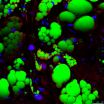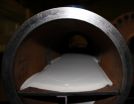Re-thinking Southern California earthquake scenarios in Coachella Valley, San Andreas Fault
UMass Amherst geoscientists produce new model of Coachella Valley faults
2014-12-08
(Press-News.org) AMHERST, Mass. - New three-dimensional (3D) numerical modeling that captures far more geometric complexity of an active fault segment in southern California than any other, suggests that the overall earthquake hazard for towns on the west side of the Coachella Valley such as Palm Springs and Palm Desert may be slightly lower than previously believed.
New simulations of deformation on three alternative fault configurations for the Coachella Valley segment of the San Andreas Fault conducted by geoscientists Michele Cooke and Laura Fattaruso of the University of Massachusetts Amherst, with Rebecca Dorsey of the University of Oregon, appear in the December issue of Geosphere.
The Coachella Valley segment is the southernmost section of the San Andreas Fault in California. It has a high likelihood for a large rupture in the near future, since it has a recurrence interval of about 180 years but has not ruptured in over 300 years, the authors point out.
The researchers acknowledge that their new modeling offers "a pretty controversial interpretation" of the data. Many geoscientists do not accept a dipping active fault geometry to the San Andreas Fault in the Coachella Valley, they say. Some argue that the data do not confirm the dipping structure. "Our contribution to this debate is that we add an uplift pattern to the data that support a dipping active fault and it rejects the other models," say Cooke and colleagues.
Their new model yields an estimated 10 percent increase in shaking overall for the Coachella segment. But for the towns to the west of the fault where most people live, it yields decreased shaking due to the dipping geometry. It yields a doubling of shaking in mostly unpopulated areas east of the fault. "This isn't a direct outcome of our work but an implication," they add.
Cooke says, "Others have used a dipping San Andreas in their models but they didn't include the degree of complexity that we did. By including the secondary faults within the Mecca Hills we more accurately capture the uplift pattern of the region."
Fattaruso adds, "Others were comparing to different data sets, such as geodesy, and since we were comparing to uplift it is important that we have this complexity." In this case, geodesy is the science of measuring and representing the Earth and its crustal motion, taking into account the competition of geological processes in 3D over time.
Most other models of deformation, stress, rupture and ground shaking have assumed that the southern San Andreas Fault is vertical, say Cooke and colleagues. However, seismic, imaging, aerial magnetometric surveys and GPS-based strain observations suggest that the fault dips 60 to 70 degrees toward the northeast, a hypothesis they set out to investigate.
Specifically, they explored three alternative geometric models of the fault's Coachella Valley segment with added complexity such as including smaller faults in the nearby Indio and Mecca Hills. "We use localized uplift patterns in the Mecca Hills to assess the most plausible geometry for the San Andreas Fault in the Coachella Valley and better understand the interplay of fault geometry and deformation," they write.
Cooke and colleagues say the fault structures in their favored model agree with distributions of local seismicity, and are consistent with geodetic observations of recent strain. "Crustal deformation models that neglect the northeast dip of the San Andreas Fault in the Coachella Valley will not replicate the ground shaking in the region and therefore inaccurately estimate seismic hazard," they note.
INFORMATION:
This work was supported by the National Science Foundation.
More: http://geosphere.gsapubs.org/content/10/6/1235.abstract
[Attachments] See images for this press release:

ELSE PRESS RELEASES FROM THIS DATE:
2014-12-08
Hamilton, ON (Dec. 8, 2014) - Researchers from McMaster University have identified an important hormone that is elevated in obese people and contributes to obesity and diabetes by inhibiting brown fat activity.
Brown adipose tissue, widely known as brown fat, is located around the collarbone and acts as the body's furnace to burn calories. It also keeps the body warm. Obese people have less of it, and its activity is decreased with age. Until now, researchers haven't understood why.
There are two types of serotonin. Most people are familiar with the first type in the ...
2014-12-08
Recently, the researchers had constructed several single molecules with dual hormone action. Now, for the first time, the researchers succeeded in designing a substance that combines three metabolically active hormone components (GLP-1, GIP and glucagon) and offers unmatched potency to fight metabolic diseases in pre-clinical trials.
The team headed by physician scientist Matthias Tschöp (Helmholtz Diabetes Center at HMGU and Metabolic Diseases Chair at TUM) and peptide chemist Richard DiMarchi (Indiana University) has been cooperating for almost a decade to invent ...
2014-12-08
Harvard Stem Cell Institute researchers at Harvard and Massachusetts General Hospital have taken what they are describing as "the first step toward a pill that can replace the treadmill" for the control of obesity - though it of course would not provide all the additional benefits of exercise.
Chad Cowan, an HSCI Principal Faculty Member and his HSCI team report that they have created a system using human stem cells to screen for compounds that have the potential to turn white, or 'bad', fat cells into brown, or 'good' fat cells, and have already identified two compounds ...
2014-12-08
Titan, Saturn's largest moon, is a peculiar place. Unlike any other moon, it has a dense atmosphere. It has rivers and lakes made up of components of natural gas, such as ethane and methane. It also has windswept dunes that are hundreds of yards high, more than a mile wide and hundreds of miles long--despite data suggesting the body to have only light breezes.
Research led by Devon Burr, an associate professor in the Earth and Planetary Sciences Department at the University of Tennessee, Knoxville, shows that winds on Titan must blow faster than previously thought to ...
2014-12-08
New nanopore DNA sequencing technology on a device the size of a USB stick could be used to diagnose infection - according to new research from the University of East Anglia and Public Health England.
Researchers tested the new technology with a complex problem - determining the cause of antibiotic resistance in a new multi-drug resistant strain of the bacterium that causes Typhoid.
The results, published today in the journal Nature Biotechnology, reveal that the small, accessible and cost effective technology could revolutionise genomic sequencing.
Current technology ...
2014-12-08
For a small percentage of cancer patients, treatment aimed at curing the disease leads to a form of leukemia with a poor prognosis. Conventional thinking goes that chemotherapy and radiation therapy induce a barrage of damaging genetic mutations that kill cancer cells yet inadvertently spur the development of acute myeloid leukemia (AML), a blood cancer.
But a new study at Washington University School of Medicine in St. Louis challenges the view that cancer treatment in itself is a direct cause of what is known as therapy-related AML.
Rather, the research suggests, ...
2014-12-08
BOSTON and CAMBRIDGE -- The genetic tumult within cancerous tumors is more than matched by the disorder in one of the mechanisms for switching cells' genes on and off, scientists at Dana-Farber Cancer Institute and the Broad Institute of MIT and Harvard report in a new study. Their findings, published online today in the journal Cancer Cell, indicate that the disarray in the on-off mechanism - known as methylation - is one of the defining characteristics of cancer and helps tumors adapt to changing circumstances.
The researchers also showed that derangement in ...
2014-12-08
BOSTON -- Small cell lung cancer - a disease for which no new drugs have been approved for many years - has shown itself vulnerable to an agent that disables part of tumor cells' basic survival machinery, researchers at Dana-Farber Cancer Institute and the Massachusetts Institute of Technology reported.
In a study published today in the journal Cancer Cell, the investigators found that the agent THZ1 caused human-like small cell lung tumors in mice to shrink significantly, with no apparent side effects. The compound is now being developed into a drug for testing ...
2014-12-08
COLUMBUS, OH - As interest in organic agricultural and horticultural practices continues to grow, so does the need to identify alternative weed control practices. Mulching, a common practice used to control weeds and reduce the need for tillage, can also reduce insect pollinators' exposure to harmful pesticides; however, finding the right mulch materials that allow pollinators to flourish can be challenging. Caitlin E. Splawski, from The Ohio State University Department of Horticulture and Crop Science, researched the effects of several types of organic mulch on squash ...
2014-12-08
WASHINGTON, Dec. 8, 2014 -- There's probably a box of it in your fridge or cupboard, and it has a million uses: baking soda. Reactions is back with volume four of its popular Chemistry Life Hacks series, with tips on how to de-skunk your dog, clean your kitchen and supercharge your washing machine. Check out the latest in the series that's one-part MacGyver, one-part Mendeleev here: http://youtu.be/85diRmuk-ow.
Subscribe to the series at Reactions YouTube, and follow us on Twitter @ACSreactions to be the first to see our latest videos.
The American Chemical Society ...
LAST 30 PRESS RELEASES:
[Press-News.org] Re-thinking Southern California earthquake scenarios in Coachella Valley, San Andreas Fault
UMass Amherst geoscientists produce new model of Coachella Valley faults






